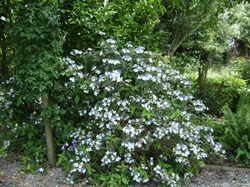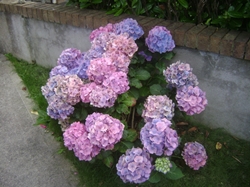
Macrophylla Hydrangeas are looking good this year, the cool and wet summer suited them. I would say they rank just behind roses in popularity, and without the need of spraying. Mop heads are the most common, and some people just regard them as common, and go for the more “refined” lace caps. Dislike of mop head hydrangeas is often a symptom of garden snobbery. I saw a very refined and minimalist Chinese garden a while ago, and one of the only touches of colour was from a group of large pink mop heads, just perfect.
Hydrangea ‘Blue Wave’ one of the best old varieties
Hydrangeas are unusual, in that while they flower on the previous years wood, as do rhododendrons, they don’t carry their flower buds through the winter. Hydrangeas make a fair bit of growth before producing flower buds, which means they flower later in the year, putting them in the company of current year flowerers, such as Buddleia davidii (and Hydrangea paniculata).But unlike buddlias, if hydrangeas are cut hard back in the spring they will produce only foliage that year and no flowers. Which is why late spring frosts are such a problem.
We had a particularly bad frost on May 7th, and a lot of damage was done. All our hydrangeas that had not got some tree cover were damaged, as were all our Japanese maples. These type of frosts are very hit and miss, plants in some gardens, or parts of gardens, get no damage at all.

Blue mophead with no flowers in centre due to late frost on May 7th. Normally stunning in full flower
There are hydrangeas now on the market such as the German bred “Forever And Ever” types. These will produce flowers on last years wood, as normal, and then later on current growth. So if plants are frost damaged there will be at least some flowers later on in the season. Or so the theory goes, time will tell.
Hydrangeas are mostly sold today as impulse plants, in full flower in large pots. It’s much harder to sell a much cheaper, but perhaps a more garden worthy named variety, in a small pot. People buy with their eyes, and a bunch of leaves in a pot even with a colour label attached, could never compete with real live flowers.
This means that varieties are selected for their ability to do well in a pot, which might not always transfer into a garden situation. For instance, the white lace cap, Teller White, was useless for me in the garden. It made a floppy plant, which was very shy to flower. I’m trying out a new lace cap this year, called White Spirit, I hope it doesn’t smell like its name!
Another important issue is that hydrangeas bought in pots in full flower, often perform very badly in the garden the following year. The reason for that is that the plants ‘forced’ into flowering in pots don’t have enough resources to make flower buds for the following year. This is easily solved by removing the flowers just as they fade, and not letting them hang on as is normal practice.

Hydrangea which can’t make up its mind between blue and pink
We all know that acid soil produces blue flowers, and limey soil pink flowers. What has always puzzled me is, how could plants that produced pink flowers be healthy, as hydrangeas dislike high PH. When I looked into it I found that pink flowers are produced also when the soil is neutral, or even slightly acidic. That’s why we see so many healthy pink hydrangeas around, as well as plenty of sad specimens with pale washed out foliage, a sign that the soil is too alkaline for them.
Reds make the best reds, and pinks the best blues, the very strong reds, can turn to a muddy violet.
In my opinion, a good well grown mid blue mop head hydrangea makes the finest blue flowered shrub, hardy in our climate. It is worth the trouble turning a good pink clone blue. On my limey soil I do it by using thick mulches of bark, applied most winters over the fallen leaves. This is easier in the long run than using chemicals, and hydrangeas love lots of organic matter.
Every day you learn something new. I saw a mop head hydrangea with unusual cup shaped florets recently, it appeared to be scented. I identified it as hydrangea ‘Ayesha’ also know as ‘Silver Slipper’, and sure enough it is scented, and got an award of merit in 1974. Another plant to add to my must have list!
John has a diploma in Horticulture from the National Botanic Gardens, a degree in Botany from Trinity College and a diploma in Tree Craftsmanship from Merrist Wood College in Surrey. He worked in the nurseries of north Germany where he got his interest in craft gardening.
He is the owner of Ratoath Garden Centre, whose slogan “mad about plants”, is not far from the truth!
Source: HortiTrends News Room






